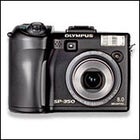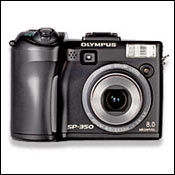Most digital cameras operate pretty well below freezing. After all, unlike old mechanical cameras that were full of moving parts and needed to be 聯winterized” with special oils and other tricks, today聮s digitals are almost entirely electronic. There are virtually no moving parts, aside from zoom and shutter button, so less to freeze up.
Olympus SP-350
 Olympus SP-350
Olympus SP-350So, the problem is not with the camera. It聮s with the battery. In cold weather the battery聮s little electrons start to move every more slowly, eventually grinding to a complete halt if they get cold enough. And when that happens the camera ceases to operate.
That said, I聮ve used pretty modern cameras (film-based, but with plenty of electronics) down to minus 20 F or so without many problems. The trick, and you聮re already onto this, is simply to keep the camera as warm as you can. For a compact digital camera, that isn聮t much of a problem. There聮s bound to be a pocket that can hold it, or you can hang it next to your chest in a case with a neck strap and zip a jacket over it. Leave the camera out in the open for 40 to 50 minutes, and, depending on the temperature, it will shut down.
The other thing to do is carry spare batteries and keep the batteries warm. After all, that聮s really the objective. Keeping batteries in a pocket will keep them at pretty close to body temperature, and they聮ll work just fine. Then, swap the batteries out of the camera every hour or so. This is easier and more affordable with a camera that uses batteries such as AA size, versus one that uses a proprietary (and, expensive) battery. But for any camera it聮s always possible to buy an extra battery or three.
You聮ve seen our picks for 2006 Gear of the Year, and now the entire is online. Check out this year聮s 400-plus, must-have gear items, including .


